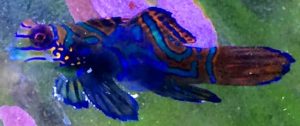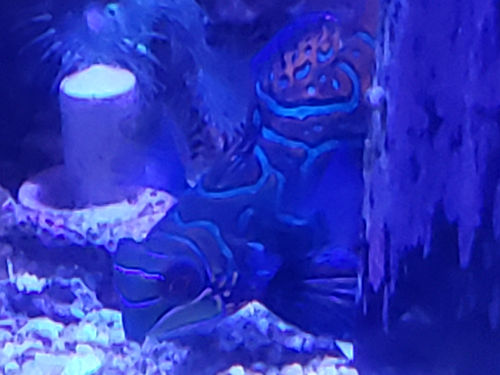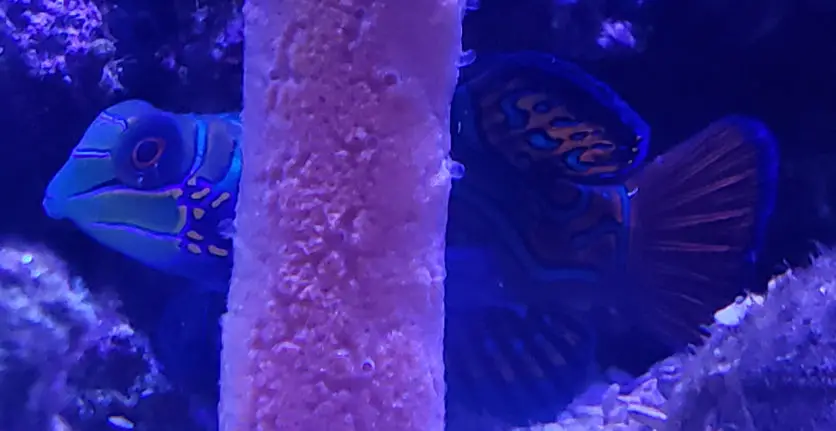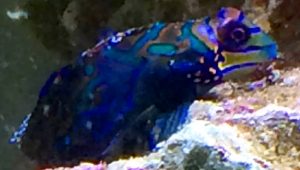
Synchiropus splendidus
| Difficulty | High |
| Minimum Tank Size | Variable, see feeding section |
| Diet | Carnivore |
| Water Parameters | 72-78 F, pH 8-8.4, Salinity 1.020-1.025 |
| Aggression | Peaceful to non-mandarins |
| Size | 4" |
The Green Mandarin is one of the most exotic salt water fish available. Their behaviors mimic that of a humming bird, as do their feeding habits. While mandarins can come in a variety of colors and sizes, the Green Mandarin is a mixture of blue, orange and green.
The Green Mandarin is a peaceful fish capable of extreme, but short, bursts of speed which leave only a dust trail visible. This allows them to hide from aggressive fish, or simply dash away when startled. The Green Mandarin does swim in the water column much more frequently then other members of the dragonet family but still spends plenty of time picking the rocks and glass for copepods, making it a mixture of bottom dweller and free swimming fish.
Diet & Feeding
Green Mandarins are constantly hunting for various pods to eat in the tank. Pods are small crustaceans that offer high amounts of nutrition. The ones most frequently used to feed Green Mandarins are copepods and amphipods, with Tisbe Pods (Tisbe biminiensis) being the most frequently used pod.
While tanks are often able to keep up production of pods with the mandarins intake, they cannot be sustained. For example a Green Mandarin who eats 1,000 pods per day in a tank that produces 1,000 pods a day sounds possible. However as the cycle continues the pods will be of younger and younger age, making them less likely to reproduce. Eventually the pods will mostly be juvenile and unable to reproduce, letting the Green Mandarin wipe out the entire population!

How can this be combated? Green Mandarins will revert to eating live foods when either under stress or simply when comfortable around your method of distribution, as seen in the above video. The most common way live foods are given to mandarins are via rigid tubing with pipettes or turkey basters. Slowly get the Green Mandarins used to the devices presence by moving it closer each day. When they do not run away you may attempt feeding.

Green Mandarins one of the most picky dragonet family members and will often only eat Nutramar Ova or live brine shrimp. Nutramar is difficult to find, but you may be able to have your local fish store special order it. Live brine shrimp can be bought more easily or even grown using cultures. However if you are going to be culturing food I highly recommend you learn how to culture copepods.
To feed the Green Mandarin any of these foods simply shut off the power heads while they are hunting, preferable on the substrate or a flat rock with nothing above it, and ready the pipette or baster. Place the tool directly in front of the mandarin, the closer the better, and slowly release the food. It may take several attempts, and if so it is best to net or suck out the food using a baster and try again. The mandarin will stop, look at the food for a short while and either ignore or attack it. Feed them as long as they are interested and scoop out any excess food to avoid water contamination. Keep in mind that other fish will try to steal this food. be discrete or feed the other fish at the same time as your mandarin.
I personally kept a Green Mandarin in a 10 gallon tank by feeding them 4-5 times a day. This was a bit expensive but allowed me to start up a copepod culture and replenish the tank he and his mate had decimated. With frequent feeding they may be kept in smaller tanks. If no supplementary feeding is planned they should be limited to well aged, copepod packed 50+ gallon tanks per mandarin. For extra safety use this in combination with a refugium or copepod culture.
Green Mandarin Aggression

A Green Mandarin Hunting
Mandarins are peaceful and will not attack any other fish except other mandarins. This is seen by aggressive swimming and constant displaying of the dorsal fins. If the smaller mandarin does not swim away fin nipping and tail pulling are common results. The larger, more dominant mandarin will keep harassing the other until either
a.) The other mandarin dies/is removed
b.) The other mandarin shows it is the opposite gender
If the mandarins are opposite genders they can coexist peacefully and even spawn eggs. To keep large numbers of mandarins, which I highly advise against due to food constraints, you will need 2-3 females per male.
Breeding & Sexing Green Mandarins
Mandarins are one of the easiest fish to find genders on. The Males have much larger front dorsal fins than the females.
For breeding you will need to adjust your tank parameters a bit.
- Temperature of 75-80 F
- Salinity 1.024-1.026
- pH 7.7-8.3
- 0 Ammonia/Nitrite
- Near 0 Nitrate
- >1 Phosphate
- Frequent Feedings
- Frequent Water Changes
- Sand Substrate
Mandarins will not spawn when hungry, and may even turn hostile towards one another if they food is scarce enough. When well fed the male will begin courting the female. She will either respond and follow him around or ignore him. After a few courting sessions she will begin to swell with eggs and become more accepting of the males advances.
After enough courting has taken place the Green Mandarins will start doing ‘rises’ in which they lock fins and swim to the surface of the water. This often happens 3″-4″ from the substrate and is more successful in taller tanks. At the top of the rise the mandarins will swim apart and down to the sand bed. After this they will either resume courting and do additional rises, start hunting for food or bury themselves in the sand. Eventually at the end of the rise the mandarins will release their eggs and genetic material, fertilizing the eggs before they both return to the bottom of the tank.
The female can lay over 300 eggs, with the quantity greatly depending on her health. The same can be said for the males fertility. If you intent to raise Green Mandarin fry it is essential you scoop out as many eggs as possible and place them into a separate tank. The eggs do best when kept suspended in the water without any rough force impacting upon them. This is easy to replicate by using a model of the kreisel.
The eggs tank should be kept as clean as possible, with the water temperature ranging between 74-79 F. The average hatch time on these eggs ranges between 12-16 hours after spawning. Once hatched Green Mandarin fry must be fed using small foods. The best foods to use for raising mandarin fry are Cyclopeze, Hikari enriched brine & mysis shrimp, Omega 3 brine shrimp and piscene energetics. The frequent water changes required to keep these fry alive will quickly deplete your foods, making strainers highly effective for reusing foods.
Once the fry have developed enough they can be fed using copepods and rotifiers, with copepods being my more common choice. Fry may be introduced to the tank when they reach 1″ in size, but I personally wait for 1.5″ to lessen bulling/improve tolerance. Always drip acclimate these fry, as their tank is often cooler than he main tank. Introduce them at lights out for the best results.
Remember: If you plan on multiple mandarins it is highly advised that you start your own copepod culture. Mandarins are aggressive pod hunters and can wipe out pods entirely when left unattended.